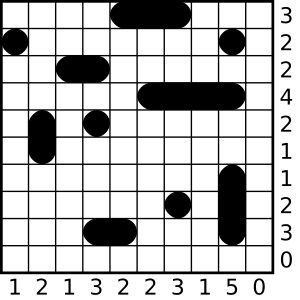Battleship (puzzle) facts for kids
The Battleship puzzle is a fun logic game! It's also known by names like Bimaru or Solitaire Battleships. This puzzle is based on the classic Battleship guessing game. It has been featured in many puzzle competitions, including the World Puzzle Championship. You can also find it in puzzle magazines, like Games magazine.
The Solitaire Battleship puzzle was created in Argentina by Jaime Poniachik. It first appeared in 1982 in a magazine called Humor & Juegos. The puzzle became much more popular around the world after its first appearance at the World Puzzle Championship in New York City in 1992. It then showed up in Games magazine the next year. It's still a regular puzzle in that magazine today!
In Battleship, you play on a grid of squares. Hidden ships of different sizes are placed on this grid. Numbers next to the grid tell you how many squares in each row or column are taken up by a ship part.
Contents
How to Play Battleship Puzzles
In the Battleship puzzle, a group of ships is hidden on a square grid. Usually, this grid is 10x10 squares big. The ships include:
- One battleship, which is four squares long.
- Two cruisers, each three squares long.
- Three destroyers, each two squares long.
- Four submarines, each one square long.
Placing the Ships
Each ship takes up a certain number of connected squares on the grid. They can be placed either straight across (horizontally) or straight up and down (vertically). An important rule is that no ship can touch another ship. This means they cannot touch even at the corners (diagonally).
Your Goal
Your main goal in the puzzle is to find out exactly where all the ships are located. Some puzzles might give you a few starting clues. These clues could show you:
- A submarine (a single square ship).
- An end piece of a longer ship.
- A middle piece of a longer ship.
- A square that is just water.
Also, every row and column has a number next to it. This number tells you how many squares in that specific row or column are part of a ship.
Different Puzzle Sizes
Sometimes, you might find versions of the Battleship puzzle that use bigger or smaller grids. When the grid size changes, the number and size of the hidden ships also change to match. There are even versions that use a hexagonal grid instead of squares!
Smart Strategies for Solving Battleship
Solving a Battleship puzzle can be very rewarding! Here are some basic tips to help you find all the hidden ships:
Filling in the Blanks
- If you see a ship segment, try to add more parts to it if it's not complete.
- If you know a square cannot have a ship part, draw water there. This helps you narrow down possibilities.
- Look at the numbers next to the rows and columns. If a row or column has the same number as its empty squares, you know all those empty squares must be part of a ship!
Advanced Solving Tips
- Think about the largest ship that you haven't found yet. Where could it possibly fit on the grid without touching other ships or known water?
- Pay close attention to rows and columns that are almost complete. Often, there's only one way to finish them correctly. This can give you big clues for other parts of the puzzle.
Battleship Puzzles and Computers
The Battleship puzzle is a complex problem for computers to solve. It belongs to a group of problems called NP-complete problems. This means it can be very hard for a computer to find the solution quickly, especially as the puzzle gets bigger.
In 1997, a popular computer game version of Battleship was released. It was called Fathom It! and was made for Windows computers. Moshe Rubin, who used to write for the Battleship column in Games magazine, helped create it.


